Church Acquires Handwritten Testimony of Italian Saint Converted by Untitled Book of Mormon
Contributed By R. Scott Lloyd, Church News staff writer
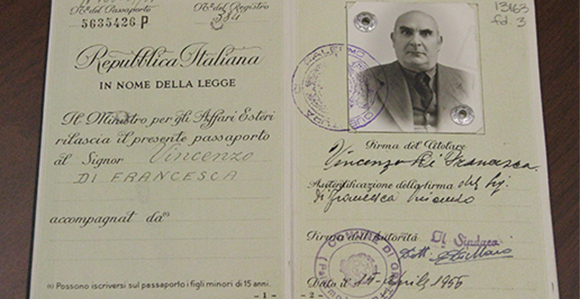
Passport of Vincenzo Di Francesca, who found a copy of the Book of Mormon without a title page or a title on the cover and was baptized some 40 years later after finding the Church and struggling for an opportunity to be baptized.
Article Highlights
- Vincenzo Di Francesca found a copy of the Book of Mormon with no title page in 1910.
- In 1951, Francesca found the Church and was able to be baptized.
- The Church recently acquired a letter by Francesca detailing his conversion.
“I prayed to the Eternal Father in the name of His Son, Jesus Christ. I asked Him to tell me if this book was of God and if it was good.” —Vincenzo Di Francesca
Related Links
Millions of Latter-day Saints became acquainted with the remarkable conversion story of Vincenzo Di Francesca through the 1987 Church-commissioned movie How Rare a Possession: The Book of Mormon.
Now, 30 years after the movie’s release, the Church History Department has acquired the handwritten testimony of Francesca, who, as a pastor in an Italian parish in New York City in February 1910, found a soiled copy of the Book of Mormon without a title page and with no title on the cover.
The dramatic story of his conversion to the restored gospel after going many years without knowing the title of the book or where to find the Church before ultimately being baptized in 1951, is one of two conversion stories depicted in the movie, the other being that of Elder Parley P. Pratt, a 19th-century Church leader.
The newly acquired document is a letter written by Francesca in 1966, the year of his death, to Elder Stephen O. Gibson, a Church missionary serving in Italy at the time. It was acquired from him on August 3, 2016, for the Church History Department by Elder Lorenzo and Sister Virgina Semadeni, who are serving a Church-service mission in the Italian Project of Global Support and Acquisitions in the Church History Department.
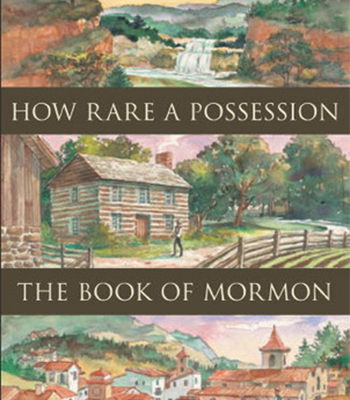
How Rare a Possession is a 64-minute film produced by The Church of Jesus Christ of Latter-day Saints. It depicts the conversion stories of Parley P. Pratt, a Church leader in the 19th century, and Vincenzo Di Francesca, an Italian pastor in the 20th century, who both join the Church after studying the Book of Mormon. It also shows several key scenes from the Book of Mormon.
Elder and Sister Semadeni focus on the first generation of missionaries to serve in Italy, and in connection with that, they contacted Brother Gibson and acquired the letter Francesca had written to him.
“He had asked Vincenzo Di Francesca to write up his conversion and testimony,” explained Matthew K. Heiss, area manager of Global Support and Acquisitions in the Church History Department.
Elder Semadeni read through the letter, written in Italian, and found that it sheds new light and gives greater detail than was depicted in the film.
Translated portions of the letter include the following:
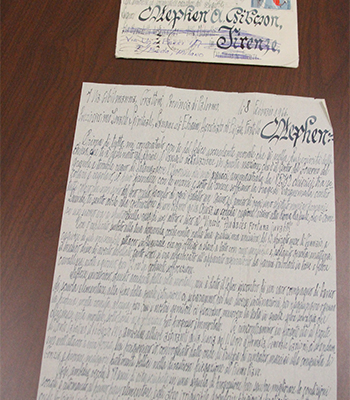
Letter written in Italian by Vincenzo Di Francesca to Elder Stephen O. Gibson, a Mormon missionary, recounting Francesca’s conversion after finding a copy of the Book of Mormon without a title page. It was recently acquired by the Church History Department. Photo by R. Scott Lloyd.
“I closed the door of my room with the key, knelt with this book in my hands, and read the 10th chapter of the book of Moroni.
“After, I prayed to the Eternal Father in the name of His Son, Jesus Christ. I asked Him to tell me if this book was of God and if it was good, true, and to mix the words of it with the four gospels of Matthew, Mark, Luke, and John in my preaching publicity.
“While I was in that pose, to await a positive answer, I felt all my body becoming cold and my heart to palpitate as if it would talk, and a gladness as if I had found something precious, extraordinary. …
“All was easy without my understanding, and the more I read [it] and the more I thought of it, the more I was impressed that I had received the assurance that God had answered my prayer in that way, and that the remainder of the book was of greatest benefit to me and to each and all who listen to its words.”
Heiss said one of the key messages from this acquisition “is there are still historical treasures that are out there waiting to be collected and preserved.”
“Elder Gibson has donated this to the Church, and it gives us validation of documents that we already have here, but it also reminds me of the fact that people who have had significant Church experiences have personal records and we are actively collecting those kinds of things.”
Heiss sees significance not only in the fact that the acquisition occurred 30 years after the movie came out but that, as the Church nears the completion of the Rome Italy Temple, “this is part of the Italians’ heritage. We’d like them to know we continue to document their history.”
He called Francesca “one of the great Church heroes, a man who sacrificed his career to join the Church and lived in isolation and kept the faith all those years.”
Born in Palermo, Sicily, Italy, Francesca had studied religion until 1905. That year, his brother, Antonine, living in New York City, invited him to attend a seminary taught by a Methodist pastor in the Italian Brandi Chapel, Elder Semadeni said.
“Soon, Vincenzo became a teacher of that congregation,” he said.
Francesca’s story was recounted in the Ensign magazine in January 1988. It is a first-person account drawn from the Church News (then called the Deseret News Church Section) of February 28, 1951; the May 1968 Improvement Era, and a letter that Francesca wrote to Avard Fairbanks, “the only known account by the author in English of his 40-year struggle to join the Church.”
In the account published in the Ensign, Francesca told of the cold February morning in 1910 when he was walking down Broadway and saw that the pages of a book lying on a barrel of ashes were being moved by the strong wind from the open sea.
Curious, he picked up the book and beat it against the barrel to knock off the ashes. He noted that it was printed in English but that the frontispiece had been torn away.
“The fury of the wind turned the pages, and I hastily read Alma, Mosiah, Mormon, Moroni, Isaiah, Lamanites—except for Isaiah, all were names I had never before heard.”
He wrapped the book in a newspaper and took it home, where he cleansed the pages with denatured alcohol and cotton so he could read the pages.
After receiving the spiritual experience from reading the passage in Moroni, he continued his services in the parish, “but my preaching was tinged with the new words of the book. The members of my congregation were so interested that they became dissatisfied with my colleagues’ sermons. When members began leaving the chapel during their sermons and remained when I occupied the pulpit, my colleagues became angry with me.”
Ultimately, he was censured by a committee in the parish and ordered to burn the book. This he refused to do.
In November 1914, he was called into the Italian army and saw action in France. At the end of the war he returned to New York, where he was admitted to his former congregation as a lay member. He was sent to Australia, where, while preaching to some Italian immigrants, he again taught from the Book of Mormon, still not knowing the name of the book. He was reported to the synod and again cut off from the church.
In May 1930, while looking up something in a French dictionary, he saw the entry “Mormon.” From that, he found sufficient information to write to the president of Brigham Young University in Provo. His letter was passed on to Church President Heber J. Grant. Francesca was sent some information, and at long last, he learned more about the Church.
World events, including a revolution in Sicily, prevented his being baptized. Not until January 18, 1951, was he baptized and confirmed on the island of Sicily by Elder Samuel E. Bringhurst, president of the Swiss Austrian Mission. In 1956, he received his endowment at the Swiss Temple in Bern.
Francesca never married. Until his death, he lived with his sister in Sicily, who arranged a Catholic funeral for him, then gathered his effects and gave them to LDS missionaries who turned them over to the mission president. Some of these, including what is purportedly that Book of Mormon copy he found in 1910 in New York City, were conveyed to the Church archives in Salt Lake City.
The movie in which his story is recounted, How Rare a Possession: The Book of Mormon, is still available for purchase on DVD from Church distribution centers.
“He continues to be a hero among the Italian Saints,” Elder Semadeni said of Vincenzo Di Francesa.
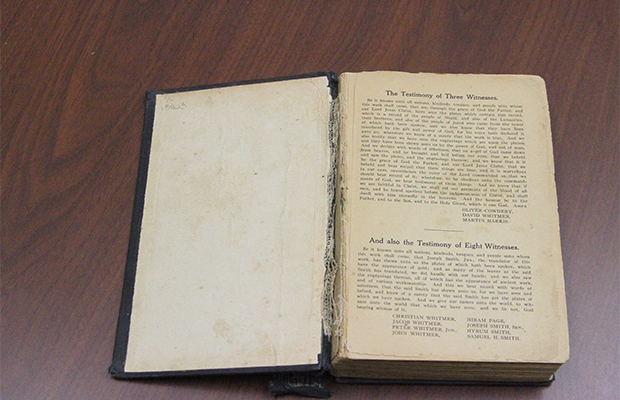
This copy of the Book of Mormon without a title page or a name on the cover is purportedly the one found by Vincenzo Di Francesca on a barrel of ashes in New York City. It is in the archives of the Church History Department. Photo by R. Scott Lloyd.
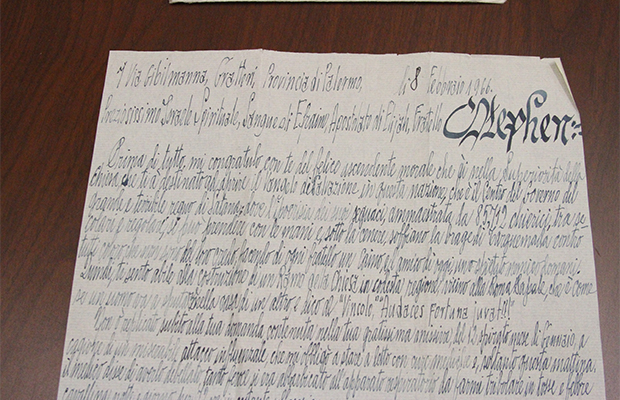
Letter written in Italian by Vincenzo Di Francesca to Elder Stephen O. Gibson, a Mormon missionary, recounting Francesca’s conversion after finding a copy of the Book of Mormon without a title page or titled cover. It was recently acquired by the Church History Department. Photo by R. Scott Lloyd.
